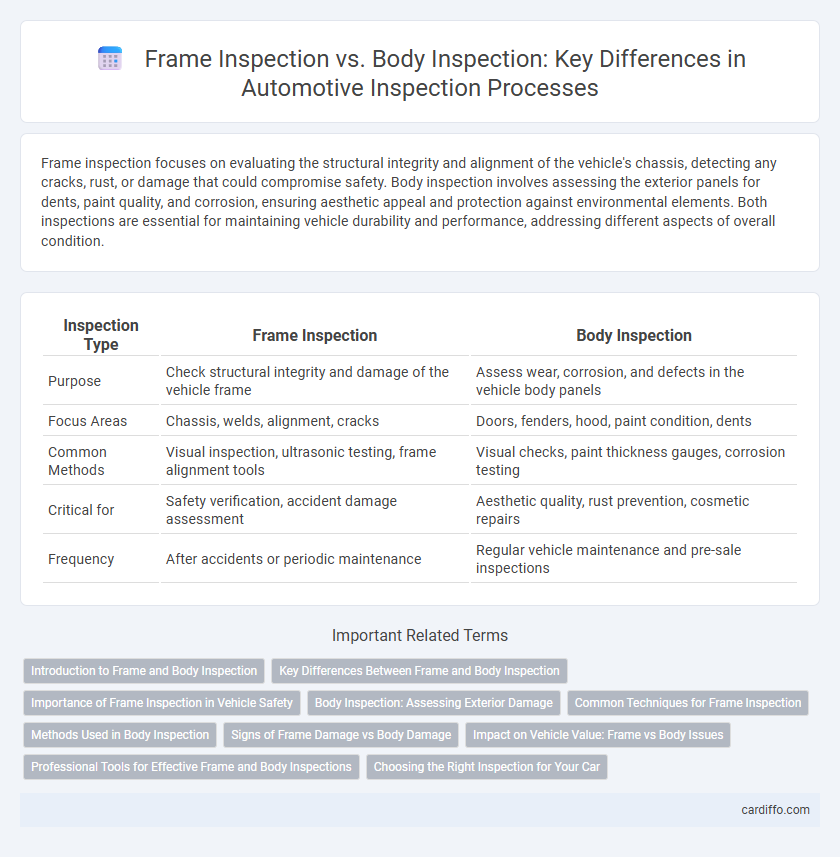Frame inspection focuses on evaluating the structural integrity and alignment of the vehicle's chassis, detecting any cracks, rust, or damage that could compromise safety. Body inspection involves assessing the exterior panels for dents, paint quality, and corrosion, ensuring aesthetic appeal and protection against environmental elements. Both inspections are essential for maintaining vehicle durability and performance, addressing different aspects of overall condition.
Table of Comparison
| Inspection Type | Frame Inspection | Body Inspection |
|---|---|---|
| Purpose | Check structural integrity and damage of the vehicle frame | Assess wear, corrosion, and defects in the vehicle body panels |
| Focus Areas | Chassis, welds, alignment, cracks | Doors, fenders, hood, paint condition, dents |
| Common Methods | Visual inspection, ultrasonic testing, frame alignment tools | Visual checks, paint thickness gauges, corrosion testing |
| Critical for | Safety verification, accident damage assessment | Aesthetic quality, rust prevention, cosmetic repairs |
| Frequency | After accidents or periodic maintenance | Regular vehicle maintenance and pre-sale inspections |
Introduction to Frame and Body Inspection
Frame inspection involves assessing the structural integrity of a vehicle's chassis, identifying any damage, misalignment, or corrosion that could compromise safety and performance. Body inspection focuses on the external panels and components, checking for dents, rust, paint defects, and proper fitment to ensure aesthetic quality and protection against environmental elements. Both inspections are critical in maintaining vehicle durability, safety standards, and resale value by detecting issues early in the maintenance process.
Key Differences Between Frame and Body Inspection
Frame inspection focuses on evaluating the structural integrity and alignment of a vehicle's chassis, ensuring it is free from cracks, corrosion, or damage that could affect safety. Body inspection centers on assessing the exterior panels and paint for dents, scratches, rust, and proper fitment, which impact aesthetics and aerodynamics. Key differences lie in the scope of evaluation: frame inspection targets foundational support components, while body inspection addresses cosmetic and surface-level defects.
Importance of Frame Inspection in Vehicle Safety
Frame inspection is crucial for vehicle safety as it ensures the structural integrity of the vehicle's core support system, preventing potential failures during collisions. Unlike body inspection, which primarily focuses on surface damage and cosmetic issues, frame inspection detects hidden cracks, bends, or corrosion that can compromise the vehicle's stability. Thorough frame assessment directly impacts crashworthiness, alignment, and overall safety performance, making it an essential part of comprehensive vehicle inspection protocols.
Body Inspection: Assessing Exterior Damage
Body inspection focuses on assessing exterior damage such as dents, scratches, rust, and misalignments on vehicle panels, ensuring structural integrity and aesthetic quality. Advanced techniques like 3D scanning and digital imaging enhance accuracy in detecting imperfections that might affect safety and vehicle value. Regular body inspections help identify issues early, reducing repair costs and maintaining vehicle performance.
Common Techniques for Frame Inspection
Common techniques for frame inspection include visual inspection using magnification tools, ultrasonic testing for detecting internal flaws, and dye penetrant testing to reveal surface cracks. Magnetic particle inspection is frequently applied to ferromagnetic frames to identify discontinuities beneath the surface. Digital imaging and 3D scanning technologies are also employed to ensure dimensional accuracy and detect structural deformations.
Methods Used in Body Inspection
Body inspection primarily utilizes non-destructive testing methods such as ultrasonic inspection, X-ray imaging, and visual examination to detect structural defects, corrosion, and weld integrity. Advanced techniques like 3D laser scanning and thermal imaging are frequently employed to ensure precise measurement and identification of surface anomalies. These methods provide comprehensive data that enhances quality control and safety assurance in vehicle manufacturing.
Signs of Frame Damage vs Body Damage
Frame inspection identifies structural integrity issues such as bent rails, cracks, or misalignment that compromise vehicle safety and handling. Body inspection focuses on surface-level damages like dents, scratches, rust, and paint inconsistencies that affect aesthetics and corrosion resistance. Recognizing frame damage signs is critical for repair decisions, while body damage primarily influences cosmetic restoration.
Impact on Vehicle Value: Frame vs Body Issues
Frame inspection detects structural damage affecting vehicle safety and resale value, as frame issues often require costly repairs and can significantly reduce market worth. Body inspection identifies cosmetic flaws such as dents and paint damage that mainly impact aesthetic appeal with less effect on overall vehicle value. Prioritizing frame integrity ensures long-term performance and higher residual value compared to addressing only body imperfections.
Professional Tools for Effective Frame and Body Inspections
Professional tools for effective frame and body inspections include advanced diagnostic scanners, ultrasonic thickness gauges, and digital measuring systems, enabling precise detection of structural damage and alignment issues. High-resolution imaging devices and 3D laser scanners facilitate detailed analysis of frame integrity and body panel conditions, ensuring accurate assessment and repair recommendations. Utilizing these state-of-the-art technologies enhances inspection accuracy, reduces repair times, and improves overall vehicle safety and performance.
Choosing the Right Inspection for Your Car
Frame inspection targets structural components crucial for vehicle safety and integrity, detecting damages like bends, cracks, or corrosion that can compromise crashworthiness. Body inspection evaluates exterior panels, paint, and alignment to identify cosmetic issues, rust, or minor deformations affecting appearance and resale value. Selecting the right inspection depends on the vehicle's history, use, and priorities, ensuring comprehensive assessment that aligns with safety standards and aesthetic expectations.
Frame inspection vs body inspection Infographic

 cardiffo.com
cardiffo.com